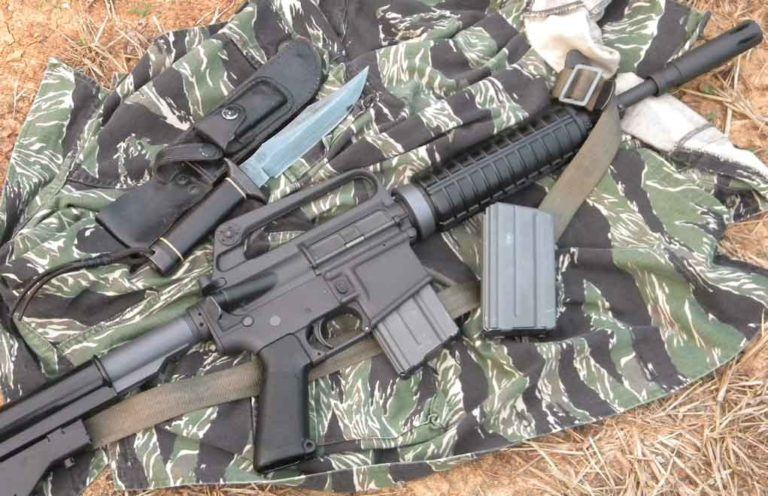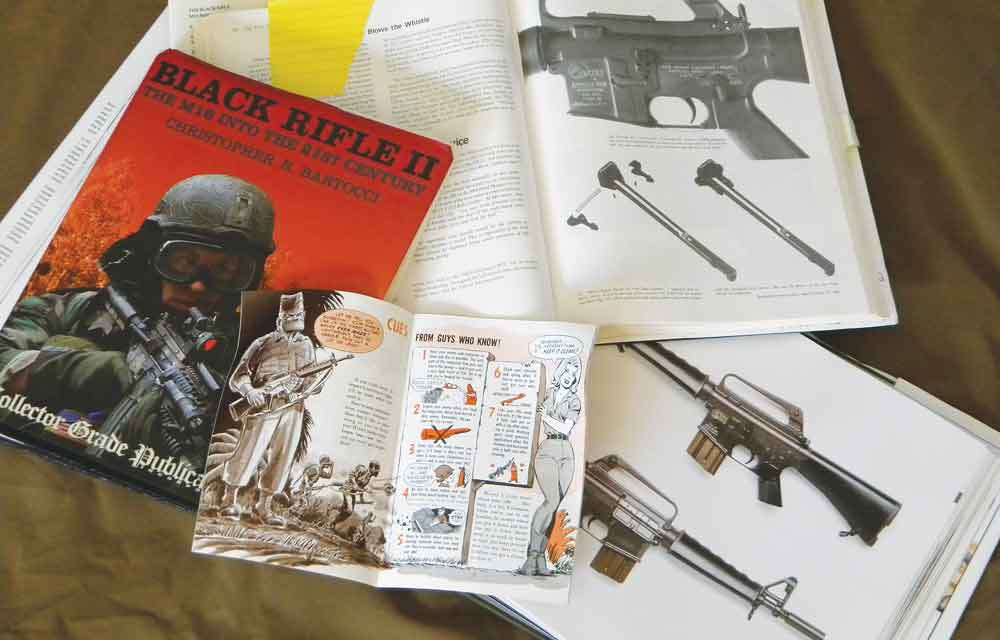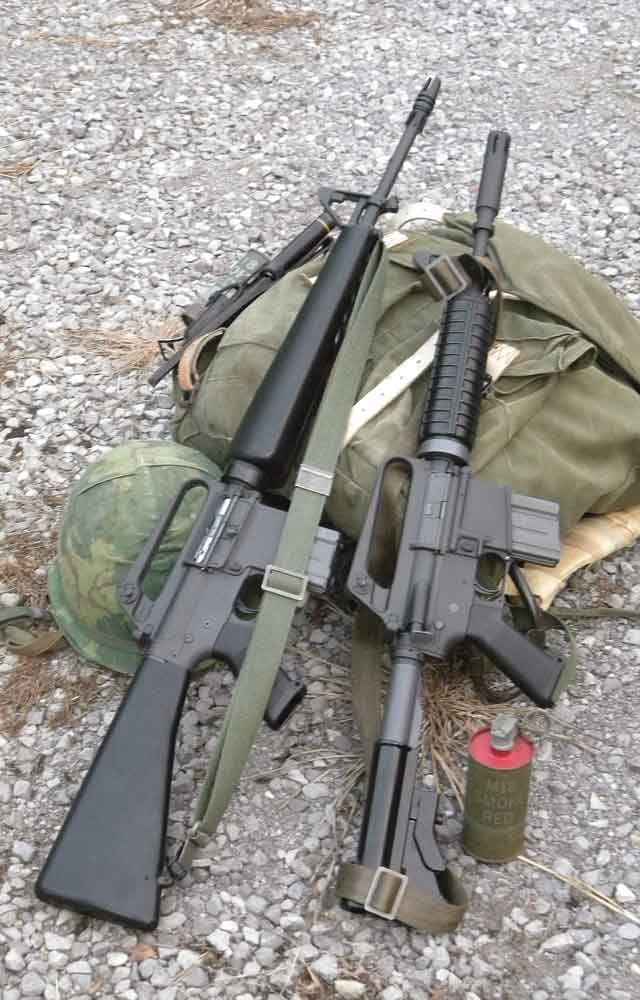
There’s something special about shooting recreations of classic AR designs, and acquiring one or devising your own isn’t as hard as it might seem.
How to get a classic AR in your hands:
- Having been around now for over 50 years, shooters are becoming more interested in classic AR designs.
- Counterintuitively, in the AR world, Reto means original, vintage means reproduction.
- There are three routes into classic ARs: buying an original, buying a reproduction or building your own.
- A number of online forums and books document AR developments and prove vital resources in a build.
- It’s important not to get caught up in recreating every detail in a build.
- First off it’s a semi-auto version of the original; secondly, original parts cost a pretty penny.
- The proper balance is somewhere between authenticity and money spent.
It’s hard to believe the AR-15 has been around for over 50 years. Colt began selling the AR-15 — a semi auto version of the M16 was created for the civilian and law enforcement markets — in the mid sixties. Since that time, the AR has evolved, following suit with the different versions of the M16. The “Black Rifle” is now old enough that it qualifies for the terms vintage and retro, and these older versions of the AR have developed a large following.

In the art and design world, vintage means an original; retro means a reproduction made to resemble the original. In the AR world, these terms are flipped. This is due to forum listings on the website AR15.com. The forum had a “Retro” category, which mainly focused on Colt’s 600 series rifles and carbines — think Vietnam. For discussion on the 700 Colts — the type weapons fielded in Desert Storm — they formed a “Vintage” category to separate the two styles.
Then you have “Fantasy” rifles/carbines, which use military-type parts but are configured in a way that never came from the factory. But, this doesn’t mean these weren’t used in the field. My go-to AR guy is Matt Weathers, a law enforcement officer and instructor for Shootrite. His dad was 5th SFG (Special Forces Group) and a member of SOG, a special operations unit that served in Vietnam. They carried Colt XM177E2s, an issued carbine with an 11½-inch barrel and collapsible stock. In order to make the carbines more reliable, troops put their upper assembly on a “rifle” lower, which has a fixed stock and a rifle-length buffer and spring. This configuration was never produced by Colt or officially issued, and yet there’s Matt’s dad in the pictures carrying it in the field. (He also used det cord for a sling.)
Getting Into A Classic
There are three options to go old school with an AR. You can buy an original. The problem with this is that a lot of the ARs we want to have and shoot were never produced in semi-auto versions, so the offerings are a little slim. You can buy new ARs that look like originals. Colt, Troy and Brownells build great rifles and carbines based on the earlier models and at affordable prices. Or, you can build your own, using old and/or new parts. Today, if you want an older model AR, there’s no reason not to have one.

I’ve put together several ARs to mimic the old versions. Early on I learned that assembling the “perfect” reproduction is almost impossible, a matter of luck or just too expensive. In the early days, Colt was building a lot of weapons. Colt was improving the designs as they went; changes were being made rapidly and they were using a lot of different contractors to produce parts. Take the grip as an example. For early model Colts, there are dozens of different grips that vary in exact size, shape and markings. Knowing exactly what part goes with what AR can sometimes be difficult.
Luckily, you don’t have to be an expert. Trying to figure out what type part you need for a build, or have questions about parts you have? Forums like AR15.com and RetroBlackRifle.com are full of people who have spent years researching and documenting the AR’s history and the various parts used. The AR community is full of good people who will be willing and eager to help in your quest.
Another great source of info are the Black Rifle series of books published by Collector Grade Publications. These two volumes get into the gritty details of the rifle’s history and development. Volume I, by Stevens and Ezell, was published in 1987 and covers the beginning and early years of development. Black Rifle II, by Bartocci, picks up there, covering later versions of the weapon like the M-4. The Vickers Guide: AR-15 Volume I is another good read. While it’s not as technical as the Black Rifle books, it’s just as interesting, and contains outstanding photographs. There’s even one section entirely devoted to reproductions, with clones of significant and historical rifles and carbines.
Cost vs. Authenticity

One word of caution on starting a build: Don’t get too caught up in all the details. Yes, I want an authentic AR, but it ain’t gonna be perfect. First off, it’s a semi-auto version of the real thing. Next, I’m not paying some of the prices that original parts are bringing. A pristine set of factory, original green furniture for an AR is going to cost you a few thousand dollars. Reproductions from Brownells will only be about eighty dollars. There are also outstanding shops like Retro Arms Works and NoDak Spud that recreate hard-to-find parts that match the factory, original specs.
With hot rods, speed is a question of money. How fast you go depends on how much you spend. The same can be said of authenticity and ARs. I’m all for authentic, but I’m not going to let that stand in the way of me having the type of AR I want. The retro/vintage thing is learning about the older weapons and having fun. You’re looking for the proper balance between “authentic” and the money you spend. It’s hard to have fun if you have to break the bank. Plus, all of my ARs end up seeing hard use. I don’t want to worry about scratching or breaking something costly and collectible.
Modern Sporting Rifles are cool. They are the pinnacle of design and function. But — given the choice — when it comes time to head to the range, I’m going to take one of my old school reproduction ARs. These are lightweight, simple and reliable weapons, the same type used in Vietnam, Desert Storm and Mogadishu. They feel good in the hand, are fun to shoot and help me connect to an earlier time and the heroic deeds of the brave soldiers who carried them.
Editor's Note: This article originally appeared in the April 2018 issue of Gun Digest the Magazine.

Next Step: Get your FREE Printable Target Pack
Enhance your shooting precision with our 62 MOA Targets, perfect for rifles and handguns. Crafted in collaboration with Storm Tactical for accuracy and versatility.
Subscribe to the Gun Digest email newsletter and get your downloadable target pack sent straight to your inbox. Stay updated with the latest firearms info in the industry.

![Best Concealed Carry Guns In 2025 [Field Tested] Wilson Combat EDC X9S 1](https://gundigest.com/wp-content/uploads/Wilson-Combat-EDC-X9S-1-324x160.jpg)


![Best 9mm Carbine: Affordable PCCs [Tested] Ruger Carbine Shooting](https://gundigest.com/wp-content/uploads/Ruger-Carbine-Shooting-100x70.jpg)
![Best AR-15: Top Options Available Today [Field Tested] Harrington and Richardson PSA XM177E2 feature](https://gundigest.com/wp-content/uploads/Harrington-and-Richardson-PSA-XM177E2-feature-100x70.jpg)
